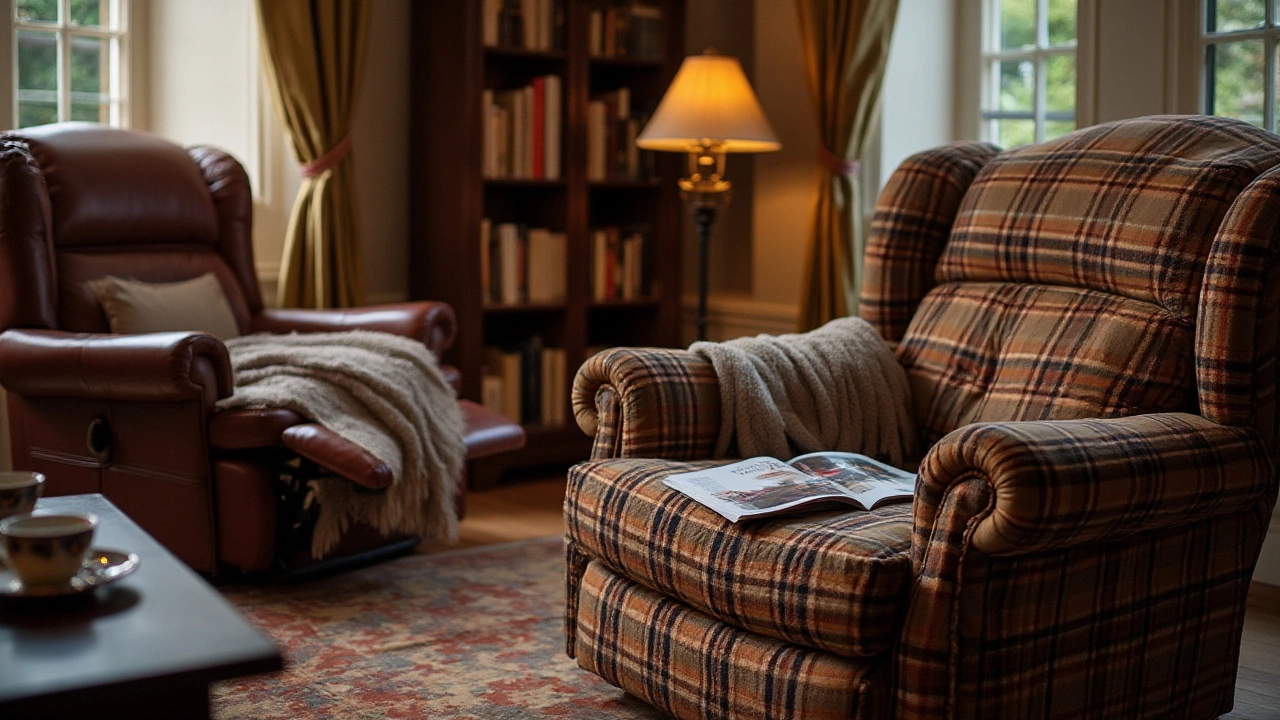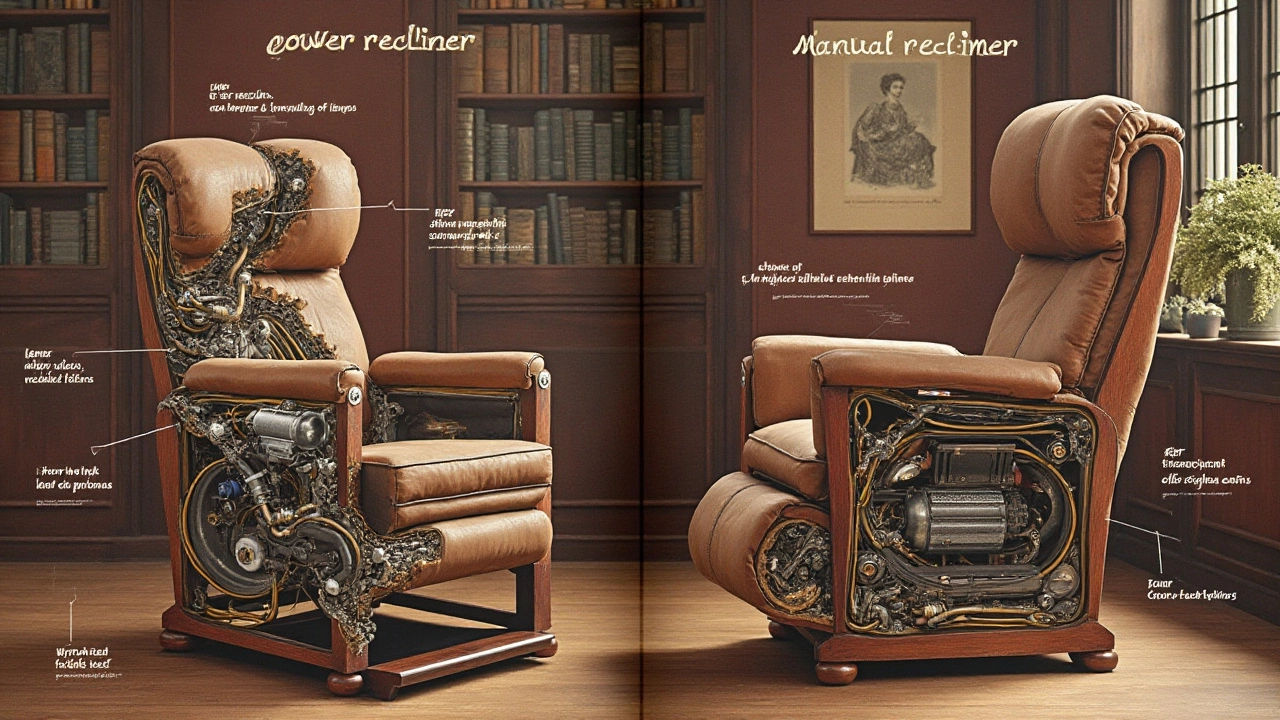 3
Feb,2025
3
Feb,2025
Choosing a recliner is not just about comfort and style; it's also an investment in your home's furniture that you'd like to last. But, between power and manual recliners, which one stands up better to the test of time? Understanding this can help guide your purchasing decision, ensuring your choice not only fits your lifestyle but also offers longevity.
Power recliners bring the latest in seating technology with motors that help adjust your position at the push of a button. This convenience, however, involves complex internal mechanisms, which might necessitate repairs over time. Meanwhile, manual recliners rely on physically adjusting the chair, which can appeal to those preferring fewer electrical components in their furniture.
In this exploration, we'll delve into what makes each type of recliner tick, how their durability compares, and what maintenance practices can extend their lifespans. From the mechanics under the upholstery to the materials used, we'll uncover the secrets that make power or manual recliners last longer.
- Introduction to Recliner Longevity
- Understanding Power Recliners
- Getting to Know Manual Recliners
- Evaluating Durability Factors
- Maintenance Tips for Longevity
Introduction to Recliner Longevity
Recliners are more than just pieces of furniture; they are personal retreats where we unwind after a long day. The quest for a comfortable yet durable seat leads many to ponder the recliner longevity question, seeking a balance between advanced functionalities and how long these marvels of comfort can be expected to last. To fully appreciate the longevity of recliners, it's essential to understand what makes them tick, quite literally.
The construction of a recliner, be it power recliners or their manual counterparts, plays a significant role in how long they endure regular use. Typically, a recliner's lifespan can range from 7 to 15 years, with heavy use potentially reducing that span. This variance largely depends on the quality of materials used, the robustness of its mechanics, and even how it is positioned in the home. Hardwood frames, for instance, often offer a more reliable and long-lasting foundation compared to softer, less durable woods, which can contribute to sagging over time.
Power recliners, while modern and convenient, house motors and electronic parts that require regular maintenance to keep them in optimal condition. According to furniture experts, the average power recliner motor has a lifespan of around a decade, but this can vary based on usage intensity and the quality of electrical components. Manual recliners, on the other hand, may skip these electronic concerns but still suffer wear and tear on moving parts like levers and springs.
"Recliners are a large part of American home life, and making an informed choice can greatly affect the experience," notes James Collins, a renowned furniture designer, highlighting the importance of knowledge before purchase.
The way a recliner is used contributes significantly to its longevity. A recliner that's subjected to constant heavy use will naturally wear out faster. Placement in the room also affects durability; recliners positioned near windows or radiators may experience fabric and structural damage over time due to UV rays or heat exposure. It's crucial for potential buyers and current owners to assess their seating habits and the recliner's environment if longevity is a concern.
Understanding the difference in maintenance requirements between power and manual recliners is another critical factor. While power options may need electrical once-overs now and then, both types benefit from regular care routines such as cleaning and checks for loose screws or damaged upholstery. By incorporating simple upkeep measures, such as those recommended by manufacturers, you can extend the useful life of these seating wonders.
Over the years, technological advancements have innovated the way manufacturers approach recliner construction. From reinforced frames to advanced fabric technology, these developments aim to enhance durability. Brands that invest in research often offer warranties reflecting their confidence in a product's lifespan, something worth considering when selecting the right recliner for your home.
Understanding Power Recliners
Power recliners have revolutionized the way we approach relaxation in our living spaces, integrating cutting-edge technology with comfort. At the heart of a power recliner is its electric motor, which empowers the effortless shift from one seating position to another with just the push of a button. This feature attracts many who seek convenience and a touch of luxury in their homes. Motorized recliners can often include multiple motors, offering varied control over different parts of the chair, from the backrest to the footrest, and even headrest adjustments in some models, providing a tailored seating experience.
When examining the durability of power recliners, several factors come into play. The complexity of electrical components means they can be prone to issues such as motor failure or system glitches, especially if maintenance is neglected. However, many modern power recliners are built to last, with innovations in durable motors and smart controls. Some high-end models even feature advanced technologies like heat and massage, which, while enhancing comfort, also add to the mechanical complexity of the chair. To address potential concerns, manufacturers often provide warranties on electrical parts, but it's essential to familiarize yourself with the terms and coverage duration.
"The most significant advantage of power recliners is the ease of use they provide to people with mobility issues," says Sarah Jacobs, a renowned furniture expert at Home Design Magazine. "The ability to adjust the chair without relying on physical strength can be a game changer for aging individuals or those recovering from injuries."
Additionally, the market offers a wide range of styles and materials, from luxurious leathers to eco-friendly fabrics, allowing buyers to choose based on aesthetic preference and lifestyle. Thanks to technological advancements, power recliners now boast energy-efficient motors that consume less electricity while maintaining performance standards. Regular maintenance and mindful usage are key to extending their life. Cleaning the upholstery regularly, ensuring the electric parts are not exposed to moisture, and opting for surge protectors can help preserve the functionality of the electronic elements.
To offer a clearer insight into their structure and common issues, consider this basic overview of potential repairs:
- Motor Replacement: Usually covered under warranty, replacement or repair of motors can be costly without it.
- Control Panel Malfunctions: Faulty electronics generally necessitate professional intervention for diagnosis and repair.
- Mechanical Wear: Regular check-ups of the structural integrity can mitigate long-term damage risks.
For those contemplating the purchase of a power recliner, examining user reviews can be crucial, especially in understanding long-term satisfaction and reliability of specific models or brands. The internet is awash with consumer feedback, often highlighting the practicality, longevity, and common problems encountered with particular models. Ultimately, by balancing technological convenience and maintenance commitment, a power recliner can become a cherished part of your home, offering enduring comfort for years to come.

Getting to Know Manual Recliners
Manual recliners are the time-tested classics of comfortable seating, beloved for their straightforward mechanics and enduring charm. Unlike their power counterparts, these recliners rely on a lever or the simple act of pushing back the seat while using your body weight to adjust the reclining angle. This lack of electronics reduces the chance of breakdowns caused by motorized failures, making manual recliners a sturdy choice for those who appreciate simplicity and reliability. With fewer components that can go wrong, these recliners often provide a long service life, given their sturdy construction and robust materials.
When considering manual recliners, it's essential to recognize the variety available in terms of designs and functions. From rocker recliners that offer a gentle motion perfect for relaxation to wall-huggers ideal for smaller spaces, manual recliners can fit a range of needs and room sizes. The choice largely depends on personal preference and the available space. Their mechanisms, though simple, are crafted with durable steel or heavy-duty plastics, ensuring that the core moving parts withstand repeated use. Such resilience is a hallmark of manual recliners and is particularly appealing for families with young children who might enjoy the occasional romp on dad's favorite chair.
According to recliner longevity statistics, manual recliners often see fewer repairs compared to powered options. This is partly because fewer moving parts mean less can go wrong. Of course, material quality and craftsmanship also play vital roles in a manual recliner's durability. Invest in a piece made with premium upholstery, resilient frames, and thick padding to ensure it remains a staple in your living room for years. According to a 2021 report by the Furniture Industry Research Association, manual recliners generally boast an average lifespan of about 7-15 years, with many lasting even longer under the right conditions.
"The simplicity of manual recliners not only enhances their longevity but also contributes to a more intimate connection with one's furniture, as it requires a hands-on interaction," remarks interior designer and recliner expert Jane Rutherford.
One important consideration is the recliner's weight capacity. High-quality manual recliners often come with detailed specifications indicating the maximum weight they can support. Checking these details can be crucial, particularly if the intended users vary in weight. Additionally, positions offered by the recliner longevity depend on the model, with some providing multiple lockable positions for customized comfort. Sticking to these settings rather than forcing a chair into positions it isn't designed for is a simple but often overlooked way to extend its life.
To ensure your manual recliner remains in good shape, regular maintenance is recommended. This includes tightening any loose screws, oiling moving parts to avoid squeaking, and spot cleaning stains immediately to prevent fabric wear. As with many types of furniture, pet claws and direct sunlight are foes to a recliner's material integrity. By investing time in routine care, you preserve the recliner’s look and functionality.
Evaluating Durability Factors
When it comes to assessing the longevity of recliners, several factors contribute to their durability. Understanding these aspects can make a huge difference in ensuring your purchase sustains years of comfort and use. Let’s start with the materials used. Wood and metal play pivotal roles in the structure of recliners. Hardwood frames are renowned for their strength and stability, often outlasting softer woods like pine. Additionally, heavy-grade metal frames provide robustness, especially in power recliners where the added weight and stress of electric motors can be taxing. The types of screws, bolts, and other hardware also matter. Chairs crafted with high-quality fasteners resist loosening over time, maintaining the mechanics' integrity.
The upholstery is another crucial factor. Leather and high-quality fabric can vastly differ in longevity. Genuine leather, while more expensive, offers excellent durability, resisting wear and tear, and even improving its appearance with age. Fabrics, particularly those treated to be stain-resistant or those with a tight weave, can be more durable than their cheaper counterparts. However, all upholstery should be regularly cleaned and conditioned. Stitching quality shouldn’t be overlooked either. Double stitching ensures that seams remain intact, preventing rips that could otherwise shorten the life of a chair.
Now, let's talk about the mechanics. The recliner longevity often hinges on the durability of its mechanical parts. For manual recliners, simple mechanisms with fewer moving parts generally face less risk of malfunction. Conversely, power recliners with their motors and electrical components require more detailed care. Choosing recliners with reputed motors, like those from the Okin or Limoss brands, can be wise, given their track record for reliability. An overlooked aspect is the wiring and its insulation quality. Ensuring these elements meet safety and durability standards can forestall electrical failures.
Frequency of Use
The lifestyle of the user plays a significant role in recliner durability. Regular use naturally leads to more wear and tear, but awareness of this can guide better usage habits. For instance, not using the reclining function excessively or alternating seats can distribute the wear more evenly across the furniture. It’s a simple trick that often gets ignored but can drastically extend the life of both manual recliners and power versions.
A thoughtful routine of maintenance can increase the useful life of recliners dramatically, according to industry experts at Furniture Today.
Some might argue that the investment in a power recliner is higher due to potential repair costs. This takes us to the maintenance angle. Regular checks, especially for power models, make sure motors and joints function smoothly. Lubricating joints can prevent squeaking and sluggish movements, and this small dedication goes a long way in a recliner's life.
Environmental Impact
Finally, don't forget the environmental conditions where a chair is placed. Humid environments can cause certain materials to degrade faster, particularly if the framework includes metals susceptible to rust. Similarly, constant exposure to sunlight can fade and weaken upholstery. Positioning recliners away from direct sunlight and maintaining a stable room climate can prevent premature aging of the materials, thereby safeguarding the investment in your recliner longevity.
By considering these durability factors, both consumers and manufacturers can align their expectations and priorities to ensure whether a manual or a power recliner fits the bill for comfort and endurance over the years.

Maintenance Tips for Longevity
When it comes to ensuring your recliner continues to offer comfort and support for years to come, maintenance plays a crucial role. Whether you own a power recliner or a manual recliner, establishing a routine care schedule can significantly enhance its lifespan. Let's dive into some essential practices that can help preserve your chair's functionality and aesthetic appeal.
Regularly Clean and Inspect
A vital aspect of keeping your recliner in top condition is regular cleaning and inspections. Dust and debris can accumulate over time, becoming abrasive and causing wear, particularly on moving parts. For fabric recliners, vacuuming weekly can help remove dirt and prevent it from embedding into the material. If your chair is leather, a specific leather cleaner can keep it supple and reduce the risk of cracking. During these cleaning sessions, take the time to inspect the mechanical components. Look out for any loose screws or signs of wear that might need addressing before they become bigger issues.
Lubricate Moving Parts
The mechanisms of both power and manual recliners rely on smooth motion, often facilitated by metal joints and moving components. Lubrication is key here. Make it a point every few months to apply a suitable lubricating oil to the joints and tracks. This reduces friction, minimizing wear and the chance of noisy operation. For power recliners, ensuring the motor is clean and free from obstruction is also a good practice. Repeatedly failing components might often be a sign of neglected lubrication.
Protect Against Sunlight and Heat
A lesser-known foe of recliners is sunlight and excessive heat. Direct sunlight can fade fabrics and dry out leather, leading to premature aging. Consider positioning your recliner away from direct sunlight or using window treatments to diffuse the light. Additionally, keep the recliner away from heat sources such as radiators or fireplaces. Heat can dry both fabric and leather, compromising their structural integrity. Fabric protectors and conditioners for leather can offer an extra layer of protection against these environmental factors.
"Proper maintenance not only extends the furniture's life but also saves on expensive repairs," says Martin Greene, a furniture maintenance expert with over two decades of experience.
Mind the Weight and Usage
Weight distribution and usage habits can directly affect the longevity of your recliner. Avoid overloading the chair beyond its weight capacity, as this can strain the mechanisms and lead to quicker degradation. Encourage family members to refrain from sudden landings into the seat, as this can damage the cushioning and frame. Additionally, if your recliner is part of a family with children, establishing rules about proper usage can prevent mishaps that may lead to repairs.
Regular Electrical Maintenance for Power Recliners
For those with power recliners, attentiveness to the electrical aspects is crucial. Ensure that the electrical cords and plugs are intact and free from damage or wear. Consider investing in a surge protector to guard against unexpected electrical surges that may affect the motor. If you notice any operational issues, such as the motor struggling or unusual noises, it might be wise to consult the manufacturer's instructions or contact a professional early on to prevent further damages.
Bonus Tip: Keep the manufacturer's manual handy. Many people overlook the importance of this document, which provides specific maintenance guidelines tailored to your recliner's particular make and model. Whether it's manual or power, these vital tips should keep your recliner comfortably in service for a long time.



